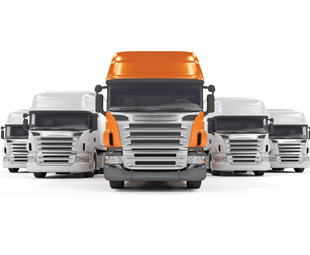Watching the numbers

Truck Test 2013 was run as a demonstration of what vehicles in the eight-tonne segment are capable of in their typical operating environment. Test coordinator FRITZ HELLBERG explains
For the results of the test to be meaningful to operators using this type of vehicle, two routes were specified. The first route, where the vehicles were tested laden up to their V-rating, consisted of a section of 34,1 km with some stops along the way, four laps around the Gerotek Ride and Handling Track that had six stops built in, and the return to base at Engen Hartebeespoort (Umfula One-Stop) again of 34,1 km. The total distance for this route from a trip time measurement point of view was 85 km.
While the Ride and Handling Track part of the route was meant to simulate stop-start operation typically encountered in an urban environment, it can be regarded as an extreme example of such as some very steep gradients and some very tight turns had to be negotiated, resulting in very high fuel consumption and low average speeds.
The second route was an undulating highway run of 247,7 km from Engen Hartebeespoort to Swartruggens and back. This route was first run laden on the second day of the test and, as these types of vehicles are frequently empty on the return trip, was repeated with the vehicles empty on the third day.
This means that between the end of the run on the second day and the start of the run on the third day, the vehicles had to be taken back to their base for off-loading. Also, on the morning of the third day the vehicles had to have their tare masses taken on the Gerotek weighbridge before starting the run at Engen Hartebeespoort. However, each vehicle was driven a different distance for the off-loading. To level the playing field, the mass of the fuel taken on the morning of the third day had to be added to the tare mass taken at Gerotek that morning to arrive at a true payload the vehicles had been carrying.
We are nevertheless aware of the competitiveness of the test and that some entrants took it very seriously. Despite our efforts to level the playing field the biggest question mark behind the results of Truck Test 2013 is perhaps what effect the different driving techniques and skills had on the results … .
Fuel consumption is assuming an ever greater part in the transport cost structure and this is the one item we particularly focus on in these tests. As with the previous Truck Test, we used the HTM TransSolve software to simulate the vehicles travelling over the routes before the test was even run. Considering the wide spectrum of operating conditions encountered in this test the TransSolve predictions were uncannily accurate.
The average speed predicted by TransSolve was 2,4 percent less than the actual speed achieved and average TransSolve fuel consumption was 5,2 percent higher than the actual consumption. It is interesting to note that the reason for the difference between the real and the TransSolve results was generally the achievement of the more professional drivers who were able “to beat the computer” in both average speed and average fuel consumption.
The fact that the average actual fuel consumption on the Track was 47 percent higher than on the highway run, further attests to the difference in operating conditions encountered in the test. The average difference in fuel consumption between the laden and empty runs was some 19 percent which is understandably much less than is the case with heavier vehicles.
A very interesting outcome of the test was the comparison in fuel consumption between “aerodynamic” vehicles and their reference vehicles. On the first day there was, as was to be expected, a maximum difference of 1,7 percent by one “aerodynamic” vehicle compared to the standard equivalent. On day two (the laden run to Swartruggens and back) improvements varying from 0,2 percent to 5,7 percent for two vehicles were recorded and on the empty run on day three improvements ranged from 3,7 percent to 11,8 percent for all three vehicles.
The overall average of the fuel saving due to the additional aerodynamics was five percent, which would be higher if the vehicles were only traveling on highways. The mass of the aerodynamic improvements ranged from 250 to 350 kg and must therefore be deducted from the potential payload. It is interesting to note that the simulations showed a potential saving varying from 0,3 percent to 7,4 percent over the range of the tests.
A problem in this regard was that two vehicles had arrived with body aerodynamic nose cones on the front of the load body without having the specified non-aerodynamic vehicles as reference vehicles. Fortunately, we had three sets of “aerodynamic” and reference vehicles to guide us in correction factors to be used in these cases to calculate what their fuel consumptions could have been without the nose cones.
Since a nose cone is not as effective as a full aerokit with side skirtings, it was decided that a correction of only 75 percent, of the average saving achieved on each day by the other “aerodynamic” vehicles, would be applied. The overall adjustment was therefore 3,75 percent resulting in the actual tested fuel consumption of the UD 95A increasing from 21,3 l/100 km to 22,1 l/100 km and for the Iveco MLC160E24, the increase was from 23,0 l/100 km to 23,8 l/100 km.”
Truck Test 2013 – technical specifications

Published by
Focus on Transport
focusmagsa




 !
From 1 Apri
!
From 1 Apri

 Big news from FOCUS on Transport + Logist
Big news from FOCUS on Transport + Logist





 FUSO: Driving the Future of Mobile Healthc
FUSO: Driving the Future of Mobile Healthc



 A brand
A brand




 Wondering about the maximum legal load for a
Wondering about the maximum legal load for a 
 The MAN hTGX powered by a hydrogen combus
The MAN hTGX powered by a hydrogen combus

 Exciting News for South African Operators
Exciting News for South African Operators
